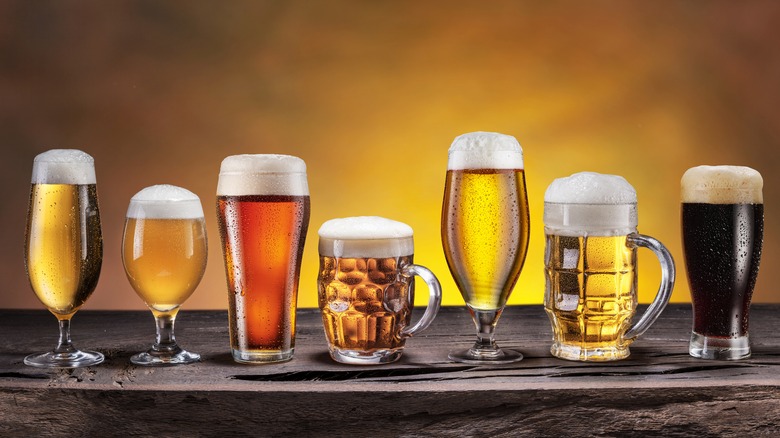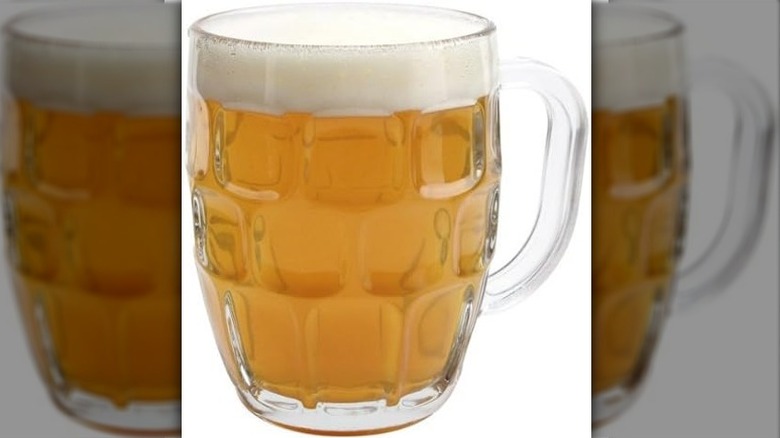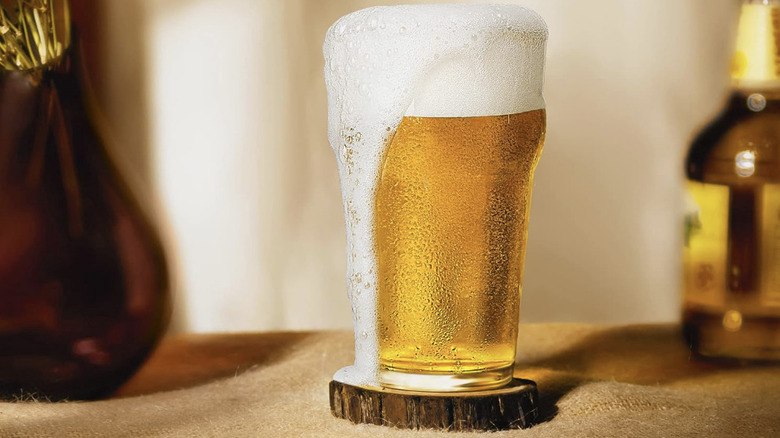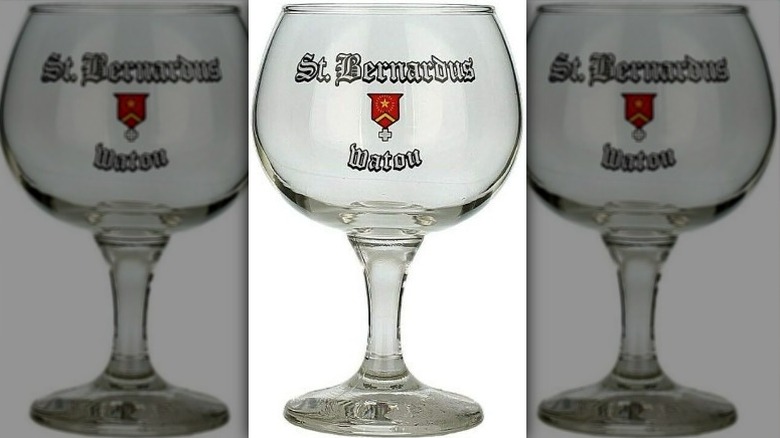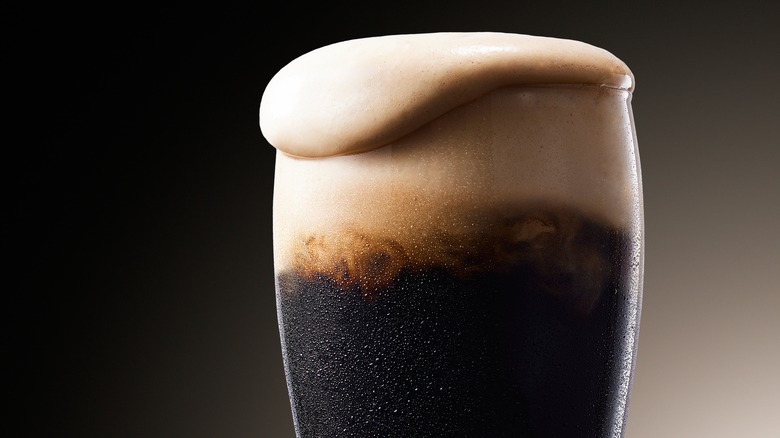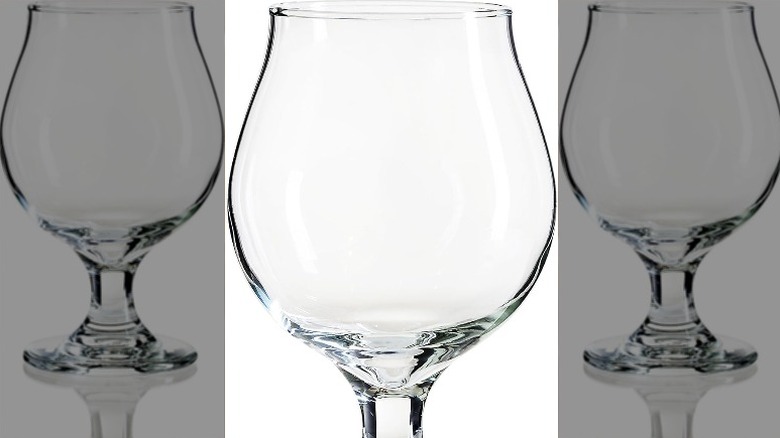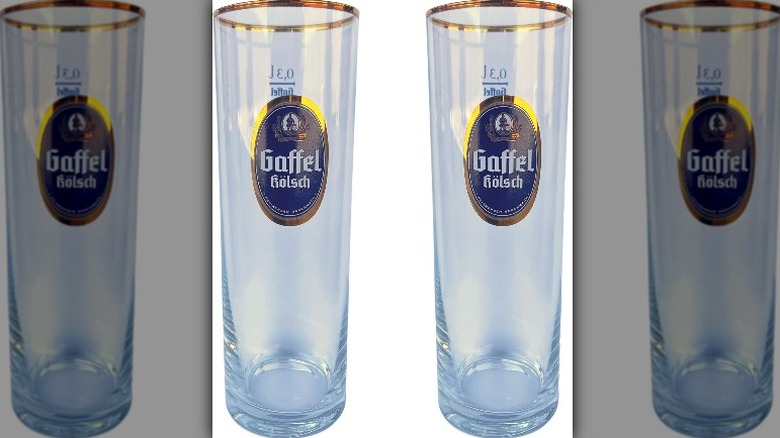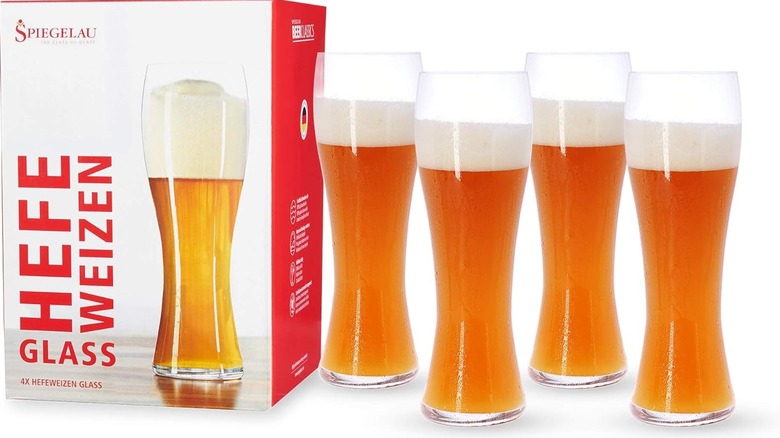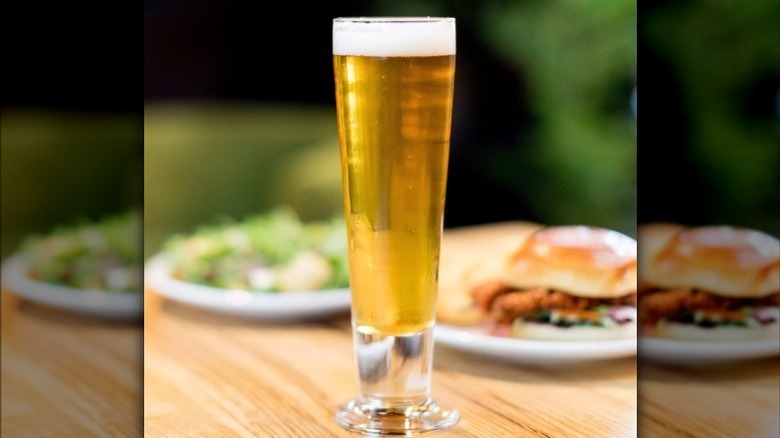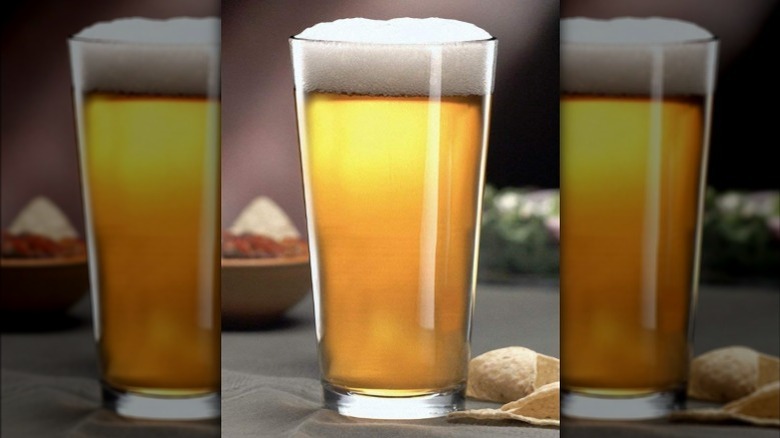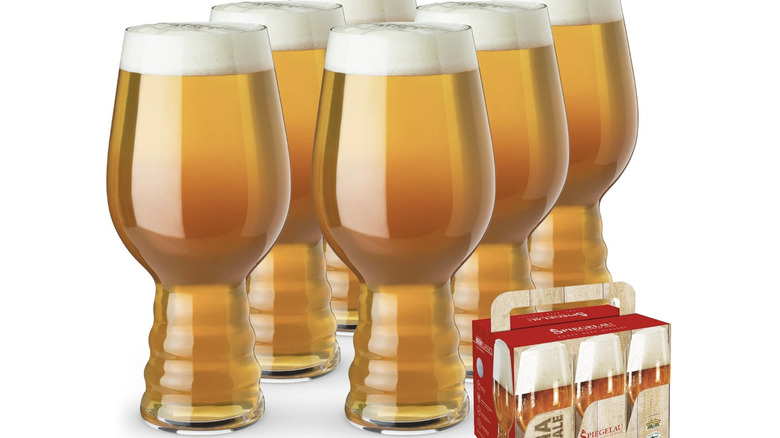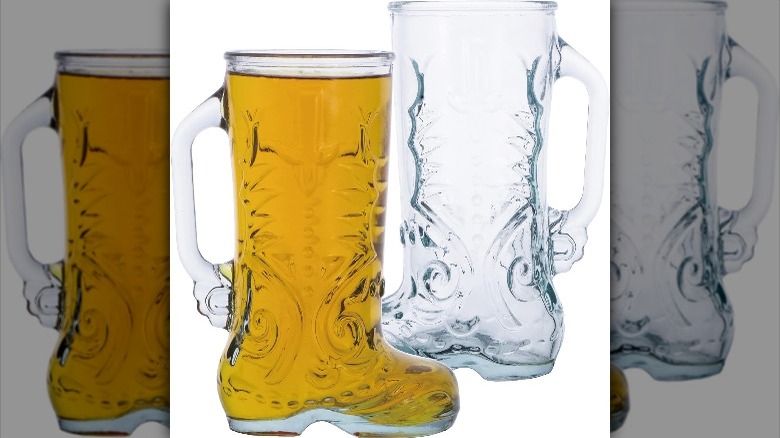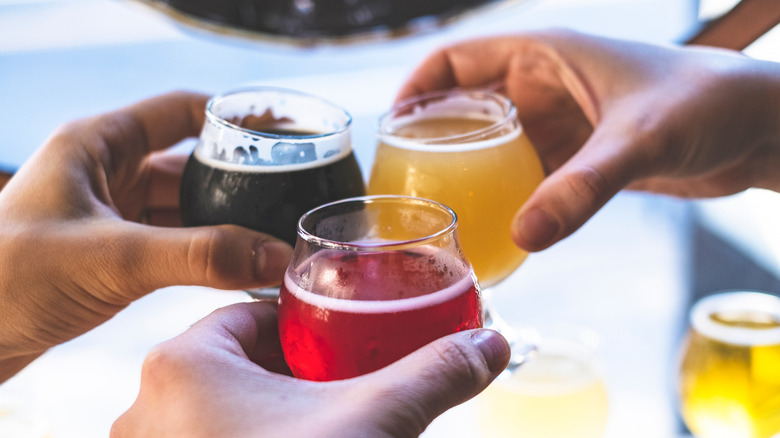13 Types Of Beer Glasses And When To Use Them
We may receive a commission on purchases made from links.
When I first encountered it, beer only came in cans or solo cups. But now that tailgates and off-campus parties are but faint memories and my options are more craft and less mystery keg, I decided it's time to step up my game and find out — just why are there so many different shapes of glasses for beer?
A better first question might have been: Why use a glass at all? It has to do with the fact that your nose and mouth are a dynamic duo when it comes to your sense of taste. When you drink out of a bottle or can, you leave your nose out of the party. There's a case to be made that the eye is an important part of this equation, as well. Pouring a beer into a glass shows off its color, clarity, bubbles, and foam, a view that can add to your excitement when you're about to partake in the refreshing elixir that's been delighting humankind since approximately 9,000 B.C.
Compared to the thousands of years that humans enjoyed beer out of stone, wood, and even sacks of leather, the proliferation and popularization of beer glasses is relatively new, given that glass wasn't mass-produced until the late 1800s. Our journey charting the history of beer glasses will take us on a trans-Atlantic voyage starting in jolly old England around 1920.
Beer mug
The first mass-produced beer glass was the 10-sided pint mug. The mug replaced pewter tankards but maintained a handle, which kept pub patrons' hands from inadvertently warming up their brews. After WWII, this model was replaced by a shorter and wider mug embellished with a grenade-like pattern. While not designed to enhance the taste of a beer, the mug's character, sturdiness, and size make it a great addition to a party, and it's recently experienced a resurgence across the pub scene. It's also very similar to the beer steins you often see Oktoberfest beer served in (though the proper style for that might be a hefeweizen glass or beer boots, which you'll meet a bit later on).
Purchase the Libbey dimple stein beer mug for $15.95 on Amazon.
Nonic pint glasses
By the 1980s, English pub owners had a new option that was easier to store and clean. These "nonic" pint glasses resemble the American pint glass we're used to seeing, with the exception of a bulge about two inches below the mouth of the glass. This bulge protects the rim of the glass from being chipped, or nicked (hence the name). A close cousin of the nonic is the tulip pint glass (see the Guinness glass). British ales, lagers, porters, and stouts will feel right at home in these vessels.
Purchase this set of four nonic glasses for $21.99 from Amazon.
Goblets and chalices
For the next stop on our tour de glassware, we'll cross the Strait of Dover from England into Belgium, where brewing dates back to the monasteries and abbeys of the Middle Ages. Here we'll encounter some dark beers and strong ales served in two classes of glasses. Goblets and their sturdier cousin, the chalice, both have wide mouths that allow for big gulps and direct the beer to the back of your tongue, home to the taste buds that detect bitterness.
Purchase the St. Bernardus nucleated original Belgian beer glass for $14.99 on Amazon.
Stout glasses
Beer drinkers recognize stout beers by their distinct flavors, the dark hues that set them apart from light beers, and the creamy mouthfeel that comes with every sip. Stout glasses augment the flavor of these beers, making them taste better than they would from a bottle or even another type of beer glass. The reason why stems from the purpose of the glass: to allow drinkers to enjoy the rich scent and flavor of the beer and to do so at a temperature that best serves the drinking experience.
A couple of types of stout glasses exist: pints, snifters, and tulips. Although shaped differently from each other, they share commonalities. Thick glass walls preserve the beer's temperature for longer periods, which permits drinkers to work through their beverages at a leisurely pace. The glasses also feature wide designs and are sometimes shorter in stature than other glasses. Their wide brims capture more of the drink's sudsy head. This ensures that the scent of the beer reaches the nose.
Of the three glass types, you'll see the pint glass most often. Bartenders regularly use this glass with Irish stout beers.
Purchase a set of four Libbey craft brews stout beer glasses for $34 on Amazon.
Snifters and tulips
The two other glass varieties, snifters and tulips, resemble the goblet family, but they narrow at the top to lock in the beer's aroma and allow for swirling, which can continually refresh a beer's scent.
For barrel-aged beers, opt for a snifter. And use a tulip stout for your favorite specialty or top-shelf stout.
Purchase these two stemmed tulip glasses for $24.99 on Amazon.
Stange Kölsch beer glass
Crossing Belgium's southeastern border, we'll encounter a few more kinds of glasses in Germany. Stange, which means "pole" in Germany, is the easiest glass to describe — it's simply a glass cylinder. The thin shape of a stange glass preserves the carbonation in delicate beers like Kölsch. Some are purposefully short in order to prevent the beer from getting too warm or losing its fizz in the glass. But don't worry — that doesn't mean you won't be drinking as much! Traditionally, stanges arrive en masse in a "kranz," German for "wreath."
Purchase a set of four Kölsch glasses with gold rims for $22 on Amazon.
Weizen glass
Weizen glasses are designed to accentuate all the qualities of Bavarian-style wheat beer. Their rounded tops preserve the fluffy foam head, enhancing your aromatic experience of the beer, while the thin glass shows off its bright hue. While some bars serve wheat beers with a lemon or orange slice, be warned — citrus juices can erode your beer's head, thus eliminating some of the fun for your nose.
Purchase a set of four Spiegelau Beer Classics Hefeweizen glasses for $55.99 on Amazon.
Pilsner glass
From Germany, we'll head further east to the Czech Republic, home to what may be defined as the Miss Universe of beers — the sparkling golden pilsner. When it was invented in the Bohemian village of Pilsen in 1842, its light clarity was like nothing the beer-drinking world had ever seen. In many ways, the tall and slender glass that widens toward the top is designed to showcase the color and carbonation of the beer that's been turning heads since the 1840s. Other light beers like bock beers and blonde ales will shine in a pilsner glass too.
Purchase a set of four Libbey Stockholm pilsner beer glasses for $24.99 from Amazon.
American pint glass
Back in the U.S., the American pint glass is more or less omnipresent in bars and restaurants. The primary appeal of this glass is utility: it's cheap to make and buy, easy to stack, difficult to break, and versatile (it's sometimes referred to as a "Shaker Pint," as its straight edges line up nicely with a shaker when crafting a cocktail). The American pint glass is more or less neutral — it won't necessarily help or harm your experience of drinking beer. The one exception here is if you're drinking something strong like a Belgian ale. In that case, if you can't get your hands on a chalice or snifter, you'd be better off with a wine glass than an American pint glass.
Purchase a set of four Libbey pint glasses for $24 on Amazon.
IPA glass
But it's not all business as usual back home in the States. In fact, one of the newest members of the beer glass universe debuted here in 2013, born from a partnership between American breweries Dogfish Head and Sierra Nevada with German glassmaker Spiegelau. This 19-ounce glass resembles an elongated goblet atop a ridged bottom. While the rounded top preserves the head and locks in flavor, the ridges agitate the beer, continually releasing the hoppy aroma and flavor characteristic of IPAs.
Purchase a set of four Spiegelau Craft IPA glasses for $44.99 on Amazon.
Glass beer boots
The glass beer boot comes with a quirky story. As it goes, to ensure a victory on the battlefield, a Prusso-German general promised his troops that if they won the next skirmish, he'd drink beer from his boot. He apparently made good on the promise because beer glasses shaped like boots were born to honor the general's most likely less-than-potable beer and the boot that held it.
Eventually, people started calling the glass "das Boot," which actually means "boat" and not "boot" in German, but no matter. The murky tale lends itself to the winding narrative of the glass, which also includes a counter origin story that says the glass beer boot was inspired by the English and their riding boots.
In any case, the shape of the glass figures prominently at one of the largest festivals in the world: Oktoberfest in Germany. While you may not care if a German beer, like a Pilsner or Kölsch, fills the glass, you will care that the toe of the boot holds an air bubble that gets larger with each sip. For the inexperienced, this equals beer-scented cologne on the shirt. The way around being the heel of the joke at Oktoberfest is to hold the glass sideways while you drink, rotating it until you get beer in your mouth and not on your shirt.
Purchase a set of two Chefcaptain glass beer boots for $24.95 on Amazon.
Does it really matter?
Just how much does the shape of a glass affect the taste of a beer? It's a subject of much debate. Some contend that the proliferation of beer glassware is nothing more than a money-making scheme, and I'd be foolish to think that wasn't part of the equation. But I'm also a sucker for a good story.
Sure, I know that the Belgians and Czechs were enjoying Trappist ales and pilsners before the widespread use of chalices and pilsner glasses, but now, these shapes have become symbols of the people who brought these beers to life. The chalice evokes the Thirteenth Century monks serving beer in their abbeys while the pilsner sparkling in its slender flute recalls the Bohemian villagers who looked on with wonder as a new clear brew flowed from their casks.
The shape of a beer glass may enhance a beer's look, taste, and smell. But for me, it certainly adds a fourth dimension — a story. And adding history to hops makes enjoying one of humankind's oldest delicacies just that much sweeter.
